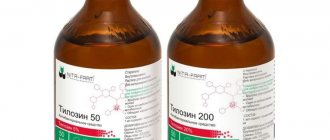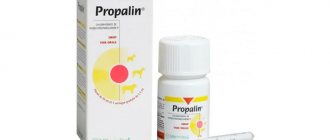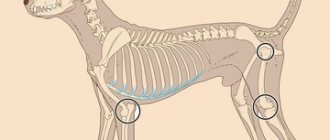Many dog owners are afraid to give them Dexafort. And for good reason: this is a serious glucocorticosteroid drug, which is prescribed according to strict indications, and if used incorrectly can cause serious disorders in the body.
In the review, I looked at how Dexafort works, when its use is necessary, in what cases it is strictly contraindicated, and what consequences it can lead to. At the end of the article you will find answers to your questions, reviews from animal owners, a list of analogues and recommendations for use.
Release form and composition
Dexafort for dogs is an anti-inflammatory drug from the group of glucocorticosteroids. Produced by the Dutch company “Intervet International BV”.
The drug is produced in the form of an injection solution. Packaged in 50 ml bottles. The average cost of one is 1,000 rubles.
The medicine contains 2 substances as active ingredients:
- dexamethasone phenylpropionate – 2.67 mg/1 ml;
- dexamethasone sodium phosphate – 1.32 mg/1 ml (equivalent to 3 mg dexamethasone).
The remaining components of the suspension are auxiliary and include sodium chloride, hydroxide and citrate, benzyl alcohol, methylcellulose, tragacanth, hydrochloric acid and water for injection.
Characteristics of Dexafort
The drug is a white injection suspension. Its active substances are dexamethasone phenylpropionate and dexamethasone sodium phosphate. Auxiliary components are sodium chloride and citrate, tragacanth, benzyl alcohol, methylcellulose, hydrochloric acid. The veterinary drug is packaged in 50 ml glass bottles. They are hermetically sealed with stoppers and reinforced with aluminum caps. The instructions recommend storing Dexafort separately from food, in a dark place out of reach of children, at a temperature of 15 to 25°C. The shelf life of the sealed medicine is 36 months from the date of manufacture. An opened bottle cannot be stored for longer than 28 days.
The veterinary drug belongs to the category of glucocorticosteroids. Dexamethasone, as the main component of the drug, is a synthetic analogue of the adrenal hormone cortisol. The substance has pronounced glucocorticosteroid properties. It has a strong anti-edematous, anti-inflammatory, anti-allergic effect.
The pharmacological effect of Dexafort is to block inflammatory mediators, including prostaglandins. The drug stimulates lymphocyte receptors and thus accelerates the biosynthesis of lipocortins, which have anti-edema and anti-inflammatory activity.
Dexafort, compared to analogues, is distinguished by its speed of action and its duration. After intramuscular administration of the drug, its maximum concentration in plasma is detected within an hour. And it lasts for 30-96 hours. The bioavailability of Dexafort when administered intramuscularly is one hundred percent. This makes the drug a strong anti-inflammatory agent.
Biotransformation of the drug occurs in the liver, and its metabolites are excreted by the kidneys. It belongs to hazard class 3 according to GOST according to the degree of impact on the dog’s body.
How it works
Dexamethasone contained in the drug is a synthetic analogue of cortisol: a glucocorticosteroid hormone of the adrenal cortex. Its action is:
- blocking inflammatory mediators, incl. prostaglandins;
- stimulation of the biosynthesis of lipocortins, which have an anti-edematous effect;
- inhibition of cellular immunity and proliferation of lymphoid tissue;
- disruption of the kinetics of T-lymphocytes attacking pseudo-infected cells.
As a result of the complex effects of dexamethasone, signs of allergies and autoimmune conditions are eliminated: itching, swelling, inflammation.
Dexafort is distinguished by two effects at the same time: immediate relief of acute reactions and the duration of the effect. This property is due to the presence of two forms of the active component:
- dexamethasone disodium phosphate – is absorbed immediately and quickly eliminates negative allergic and autoimmune reactions;
- Dexamethasone phenylpropionate is absorbed and distributed throughout the body slowly, providing a prolonged effect.
Appearance, composition and storage conditions
The white suspension is intended for injection. It is packaged in glass bottles with a capacity of 50 ml. To maintain the tightness, glass containers are sealed with rubber stoppers and rolled up with aluminum lids.
Elimination of inflammatory processes is provided by two active substances:
- dexamethasone phenylpropionate (1 ml of medicine contains 2.67 mg of this substance);
- dexamethasone sodium phosphate (its content is 1.32 mg per 1 ml).
The action of the active components is similar, but the difference is that dexamethasone sodium phosphate is quickly absorbed and immediately begins to act, but dexamethasone phenylpropionate is absorbed slowly. As a result, the drug begins to work immediately, but has a long-lasting effect.
The solution for injection also includes additional components that perform only an auxiliary function.
Dexafort can be stored for 3 years from the date of production, but subject to simple rules:
- The air temperature should be between 15 and 25˚C.
- Keep away from direct ultraviolet rays.
- The medication cannot be near food or feed.
- Children and animals should not have access to it.
Contraindications and side effects
Dexafort belongs to moderately hazardous drugs (class 3 according to GOST 12.1.007). But, like any glucocorticosteroid drug, it has a lot of contraindications and serious adverse reactions.
Thus, Dexafort is prohibited from being used for:
- diabetes mellitus;
- fungal and viral invasions, and for bacterial ones, simultaneous use of broad-spectrum antibiotics is required;
- kidney pathologies;
- heart failure;
- osteoporosis;
- hyperadrenocorticism;
- ulcerative lesions of the gastrointestinal tract;
- corneal ulcers;
- pregnancy: in the early stages it can provoke abnormalities in the development of the fetus, in the later stages it can lead to abortion or premature birth;
- simultaneously with vaccines, because corticosteroids suppress the immune system;
- together with babiturates, phenytoin, rifampicin, because the effectiveness of dexamethasone will decrease;
- 28 days after opening the bottle.
Instructions for use, side effects and contraindications of the drug
The drug is administered intramuscularly or subcutaneously (at the withers) once based on the weight of the animal. For dogs up to 20 kg - 0.5 ml, for heavier animals - 1 ml. Dexafort cannot be used simultaneously with vaccines.
It is contraindicated:
- for fungal and viral infections,
- osteoporosis,
- diabetes,
- kidney diseases,
- hyperadrenocorticism,
- heart failure.
It is used with caution on pregnant animals.
Price
The cost of the drug is about 600 rubles per 50 ml bottle.
Reviews of Dexafort for dogs
Review #1
Dexafort is the same as cortisone, that is, a rather powerful hormonal agent. Before you start using it, you should definitely consult your veterinarian. That's why I did it this way. We had a rather severe case: the dog began to itch constantly and scratched itself terribly.
We began to try a variety of remedies, but for a long time nothing helped. The veterinarian recommended that we take a course of Dexafort injections. And, despite the fact that this is a hormonal drug, we decided. It didn’t take long for the effect to appear. The dog feels good and is no longer itchy.
Victoria, Moscow
Review #2
My bull terrier had seasonal allergies since puppyhood and sneezed terribly from ragweed. He was prescribed Dexafort injections. We started piercing the dog every season and he was the only one who helped every summer. No side effects were noticed. Three injections 10 days before flowering and three injections 10 days after the season were enough.
Vladimir, St. Petersburg
Analogues of the drug
You can replace Dexafort with one of the following veterinary drugs of the glucocorticosteroid group:
| Name | What is the difference | average price |
| Dexakel 02 | Contains only dexamethasone sodium phosphate (2.64 mg/1 ml). It is better suited for non-infectious inflammations of the musculoskeletal system, systemic infectious diseases, and metabolic disorders. | 900 rub. for 50 ml. |
| Cortexon Retard | A drug based on dexamethasone-21-isonicotinate (1.25 mg/1 ml). In addition to the antiallergic effect, it has anti-inflammatory, desensitizing effects and immunosuppressive activity. Eliminates allergy symptoms, relieves swelling and inflammation. Used for post-traumatic diseases, eczema, dermatitis. | 1,100 rub. for 100 ml. |
| Dexamethasone | Another drug based on dexamethasone is in the form of disodium phosphate (2 mg/1 ml). Indicated for post-traumatic edema and arthritis, allergic dermatitis, eczema. Prohibited for infectious inflammation of the cornea. | 740 rub. for 100 ml. |
| Prednivet | A medication from the group of glucocorticosteroids, only based on prednisolone (0.025 g/1 ml). Suitable for the treatment of metabolic disorders, inflammation of the musculoskeletal system, infectious diseases, allergies, stress and shock, snake and insect bites. | 800 rub. for 50 ml. |
Reviews from veterinarians
Elizaveta, veterinarian with 15 years of experience:
“In my practice, I use different drugs, but so-called emergency drugs should always be available. I can also include Dexafort among these. It is practically indispensable for allergic reactions, which are accompanied by severe itching and other unpleasant symptoms. Helps quickly eliminate the manifestations of pathology.”
Pavel, veterinarian with 8 years of experience:
“In case of severe allergic reactions, Dexafort is a real salvation for animals. Itching and other symptoms disappear within an hour after the injection. And although the manufacturer warns about possible side effects, pets usually tolerate it well. The only drawback I think is the 50 ml bottles. Dog owners often have to pay for the suspension, which then has to be disposed of because it has expired.”
How to give a dog an intramuscular injection: video
24.04.2019
Owner reviews
Tanya: “My fox terrier will soon turn 12 years old. And, apparently, an age-related imbalance of hormones emerged: the dog began to itch constantly, broke off all his fur, and did not sleep. Tested - no allergies or parasites. The doctors threw up their hands and prescribed hormonal treatment. We chose Dexafort as the most acceptable drug. I pierced 3 times, 0.5 cubes once a week. The itching went away almost immediately, and they forgot about it for a month. But then the symptoms returned. I don’t want to stuff my pet, but now I’ll have to use Dexafort for life: I put a quarter of a cube weekly.”
Victoria: “I have a 3-year-old American Staff Terrier female. I developed an allergy to poultry meat. At the clinic she was given a Dexafort injection. Almost immediately the dog started vomiting, the dog was agitated, and then bumps appeared all over its body. After a few hours, everything went away, and at the same time the unbearable itching.”
Maria: “I have a French bulldog. This breed constantly has skin problems. The worst thing is when your pet has bumps like pimples between the pads of his fingers. They couldn’t understand what was going on until they got to a normal vet. He determined that it was an allergy to cereals: he switched the dog to hypoallergenic food and prescribed Dexafort injections. After a couple of days, the first improvements appeared, and after a few weeks the pet’s well-being improved.”
User reviews
- My fox terrier is already 12 years old. If we convert his age from dog to human, it will be about 80 years. Due to such a respectable age, hormonal changes occurred in my pet’s body, namely, a hormone imbalance. He is tormented by severe itching in the area of his back, he scratches it until it bleeds, and he’s already scared for him. The veterinarians prescribed the hormonal drug Dexafort and now it would seem that nothing should threaten the life of my pet, but after some time the itching returned again. Doctors have said that your dog will be itchy for the rest of his life due to his advanced age, so the drug can only help relieve flare-ups of itching, not eliminate it.
- Our Moska had an allergic reaction to various detergents, such as washing powder, for example. The allergy manifested itself as redness in the eyes and the appearance of itching in various places of our pet. We tried many allergy medications, tried to hide the washing powder away from the dog, wash things less often, but nothing helped - the irritation in the form of a rash on the skin did not go away. Once again we went to an experienced veterinarian, he prescribed Dexafort to treat the dog. After one injection, the allergy did not immediately go away, but Moska stopped itching and whining. Thanks to our experienced veterinarian, otherwise we were already desperate.
- My Rod is 7 months old, during training they gave him sausages and cheese, the products were not spoiled, but for some reason they caused him food poisoning and a rash in the abdomen and inside the ear. We took the puppy to the veterinarian, who gave him an injection of Dexafort 1.5 ml. I thought that now everything would be fine with my pet’s health, but after the injection, the puppy developed an insatiable need for water, he began to eat a lot and often sits on the tray to pee. I had never seen him like this before. Therefore, I began to look for any information about the effect of Dexafort on the dog’s body. It turns out that the veterinarian injected too large a dose of the drug into my puppy (his weight is only 12 kg), without warning about the possible side effects of the drug. Who knows how long the effect of the drug on the body will last and whether it will affect Rody’s future health?
- My dog has asthma. The veterinarian prescribed my pet the drug Dexafort, we give it once every two months, 1 injection. The dog feels great, enjoys life, lives to the fullest. I am pleased that Dexafort helps fight asthma in my pet, but now this drug can not be found anywhere, it is quickly sold out. There's just some kind of hunt for him. I wanted to order the drug online, but it is not available in online stores either. I also heard that Dexafort is being discontinued. Is it true?
Answers to frequently asked questions
How long can Dexafort be used?
Medicines are used mainly once or twice a week. For persistent allergic diseases, constant periodic use during the season, once a month or weekly, is possible. But such regimens are used as directed and under the supervision of a doctor with mandatory regular blood and urine tests.
There is no way to take the dog off Dexafort - we cannot find out the cause of the itching; without it, the pet sheds its fur and loses weight. Is it dangerous to constantly use the medicine once a week?
With long-term use (a month or more), glucocorticosteroids often have side effects: they are life-threatening, difficult to treat, and sometimes do not go away even after stopping the medication. This therapy is used only if the animal’s condition without treatment is worse than with it.
When is the best time to inject the suspension?
The optimal time is early morning, between 6 and 8 o'clock. If the dose is large and it is impossible to administer the solution at once, the dose is divided into 2 parts: the first injection is given before 8 am, the second – in the afternoon around noon.
Is the drug dangerous for people?
Dexafort can have a negative effect on a person. Therefore, when handling the medicine, wear protective clothing and rubber gloves. After the injection, wash your hands thoroughly with soap. In case of accidental ingestion, contact of the solution with the eyes or mouth, or if an allergy occurs, wash the solution off the skin or mucous membranes and immediately consult a doctor.
Restrictions
The highly effective drug has an impressive list of contraindications. It is not recommended to use Dexafort in the early stages of pregnancy, as it can cause congenital pathologies and anomalies. The medicine is strictly prohibited even in the third semester, as it can cause premature birth, during which the offspring may die.
You should not use a hormonal drug if you have the following diseases:
- for corneal ulcers;
- in cases of kidney dysfunction;
- for osteoporosis;
- with heart failure;
- for ulcers in the digestive system;
- in the presence of viral infections;
- for fungal diseases;
- with Cushing's syndrome (excessive production of cortisol by the adrenal glands).
Dexafort, like other glucocortisteroid drugs, is an antagonist (acts in the opposite way) of insulin, so it cannot be used for diabetes. It is not used together with vaccines. It suppresses the immune system, so the risk of complications increases. Some medications may reduce the effectiveness of the medication, so be sure to tell your doctor about any medications your pet is taking.
Note! Pets who are hypersensitive to an injection of an anti-inflammatory drug may develop anaphylactic shock. To prevent this, the cat is first given an anti-allergenic drug or injected with adrenaline.
conclusions
Dexafort, in my opinion, is the best glucocorticoid drug. It is a lifesaver for severe itching, when the dog tears the skin until it bleeds and gnaws out the fur in clumps. In this case, you need to quickly relieve acute symptoms, otherwise the condition will be complicated by a bacterial or fungal infection (see the article Fungus in a Dog).
But you need to understand that Dexafort only removes the symptoms, but the root causes remain. Therefore, after injection of the solution, it is necessary to examine and exclude the provoking factor. In most cases, these are various types of allergies (usually flea dermatitis, demodicosis, food, detergents and pet shampoos), less often - autoimmune pathologies.
I do not recommend using Dexafort constantly. Although there are cases when the cause of itching and hair loss cannot be found, and only hormonal treatment helps. But under such circumstances, I prefer to prescribe Prednivet or “human” Prednisolone tablets. You can select their minimum dosage, at which the dog’s condition will be satisfactory and no side effects will occur.
Does the drug have side effects?
If Dexafort is used as directed, the risk of side effects is minimal. You may see:
- increased appetite;
- thirst;
- as a result, excessive urination.
In rare cases, individual intolerance to the drug is observed, then analogues are selected. An overdose of dexamethasone in dogs can provoke the development of hyperadrenocorticism. Its symptoms:
- Apathy, weakness.
- Increased appetite.
- Weight loss.
- Thinning bones, porosity.
- Loss of muscle tone.
- Urinary incontinence.
- Symmetrical hair loss.
These are alarming signals, and if they are detected, you should immediately contact a veterinarian.
Instructions for use
Before using the drug, you need to shake the contents of the bottle. The drug is administered as an injection intramuscularly or under the skin in the dog's crest area.
The drug is administered into the dog’s body 1 time, subject to the dose: dogs weighing up to 20 kg - 0.5 ml of the drug, dogs weighing more than 20 kg - 1 ml. If the disease is lifelong, then the drug is used once a week during its exacerbations, but long-term use of the drug will have a bad effect on your dog’s health.
Before using Dexafort, you need to make sure that your dog does not have any disease in which the use of the drug could harm your pet’s health rather than help it. To do this, be sure to do a biochemical analysis of the dog’s urine and blood in a veterinary clinic and all sorts of other necessary procedures for an accurate diagnosis or lack thereof. Because if there is individual intolerance or when a large dose of the drug is administered, the dog’s body may be subject to irreversible processes that can lead to the death of your pet.
If you care about your pet's health, then invest in a full veterinary medical examination for your dog. The introduction of the drug in small doses into the dog’s body can cause a strong need for water and food, as well as a frequent desire for the animal to run to the toilet to pee (strong urination).
Dexafort is used to eliminate inflammatory processes occurring in the dog’s body, as well as in case of allergic reactions of your pet to pathogens.
Dexafort is used for:
- Allergic dermatitis.
- Eczema.
- Post-traumatic edema.
- Bronchial asthma.
- Joint diseases.
- For acute mastitis.
Dexafort is prohibited for use with other vaccines. Very long-term use of the drug can cause Cushing's syndrome in your dog, which in turn is characterized by a redistribution of fat in the dog's body, a general weakening of the animal's muscle tissue, weight loss and osteoporosis.
The drug should be administered to pregnant dogs with extreme caution. It is recommended to use it at the last stage of your pet’s pregnancy, since when dexafort is administered at an early stage of pregnancy, it can adversely affect the proper formation of the fetus inside the animal’s uterus.
Dexafort is contraindicated for:
- Viral infections
- Fungal infections
- Sugar and diabetes insipidus.
- Osteoporosis.
- Kidney diseases.
The price of the drug at the moment is about 1200 rubles.










